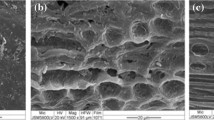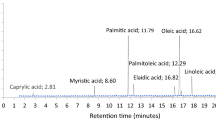Abstract
This study enhanced the production of thermostable organic solvent-tolerant (TS-OST) lipase by locally isolated thermotolerant Rhizopus sp. strain using solid-state fermentation (SSF) of palm kernel cake (PKC). The optimum conditions were achieved using a series of statistical approaches. The cultivation parameters, which include fermentation time, moisture content, temperature, pH, inoculum size, various carbon and nitrogen sources, as well as other supplements, were initially screened by the definitive screening design, and one-factor-at-a-time using PKC as the basal medium. Three significant factors (olive oil concentration, pH, and inoculum size) were further optimized using face-centred central composite design. The results indicated a successful and significant improvement of lipase activity by almost two-fold compared to the initial screening production. The findings showed that the optimal conditions were 2% (v/w) inoculum size, 2% (v/w) olive oil, 0.6% (w/w) peptone, 2% (v/w) ethanol, 70% moisture content at initial pH 10.0 and 45 °C within 72 h of fermentation. Process optimization resulted in maximum lipase activity of 58.63 U/gram dry solids (gds). The analysis of variance showed that the statistical model was significant (p value <0.0001) and reliable with a high value of R 2 (0.98) and adjusted R 2 (0.96). This indicates a better correlation between the actual and predicted responses of lipase production. By considering this study, the low-cost PKC through SSF appears to be promising in the utilization of agro-industrial waste for TS-OST lipase production. This is because satisfactory enzyme activity could be attained that promises industrial applications.



Similar content being viewed by others
References
Abdel-Fattah YR (2002) Optimization of thermostable lipase production from a thermophilic Geobacillus sp. using Box–Behnken experimental design. Biotechnol Lett 24:1217–1222
Alam MZ, Fakhru’l-Razi A, Molla AH (2004) Evaluation of fungal potentiality for bioconversion of domestic wastewater sludge. J Environ Sci 16:132–137
Aruna K, Karim K (2014) Optimization studies on production and activity of lipase obtained from Staphylococcus pasteuri SNA59 isolated from spoilt skin lotion. Int J Curr Microbiol App Sci 3:326–347
Barth G, Gaillardin C (1997) Physiology and genetics of the dimorphic fungus Yarrowia lipolytica. FEMS Microbiol Rev 19:219–237
Bhatti HN, Rashid MH, Nawaz R, Asgher M, Perveen R, Jabbar A (2007) Optimization of media for enhanced glucoamylase production in solid-state fermentation by Fusarium solani. Food Technol Biotechnol 45:51–56
Cihangir N, Sarikaya E (2004) Investigation of lipase production by a new isolate of Aspergillus sp. World J Microbiol Biotechnol 20:193–197
Cooney DG, Emerson R (1964) Thermophilic fungi: an account of their biology, activities, and classification. W. H. Freeman, San Francisco
Dandavate V, Jinjala J, Keharia H, Madamwar D (2009) Production, partial purification and characterization of organic solvent tolerant lipase from Burkholderia multivorans V2 and its application for ester synthesis. Bioresour Technol 100:3374–3381
Elgharbawy AA, Alam MZ, Salleh HM (2014) Statistical screening and optimization of factors that influence lipase production from palm kernel Cake using Candida cylindracea in solid-state bioconversion. J Pure Appl Microbiol 8:691–705
Ferrarezi AL, Hideyuki Kobe Ohe T, Borges JP, Brito RR, Siqueira MR, Vendramini PH, Quilles JC Jr, da Costa Carreira Nunes C, Bonilla-Rodriguez GO, Boscolo M, Da-Silva R, Gomes E (2014) Production and characterization of lipases and immobilization of whole cell of the thermophilic Thermomucor indicae seudaticae N31 for transesterification reaction. J Mol Catal B Enzym 107:106–113
Gopinath SC, Anbu P, Hilda A (2005) Extracellular enzymatic activity profiles in fungi isolated from oil-rich environments. Mycoscience 46:119–126
Gutarra MLE, Godoy MG, Maugeri F, Rodrigues MI, Freire DMG, Castilho LR (2009) Production of an acidic and thermostable lipase of the mesophilic fungus Penicillium simplicissimum by solid-state fermentation. Bioresour Technol 100:5249–5254
Hernández-Rodríguez B, Córdova J, Bárzana E, Favela-Torres E (2009) Effects of organic solvents on activity and stability of lipases produced by thermotolerant fungi in solid-state fermentation. J Mol Catal B Enzym 61:136–142
Iluyemi FB, Hanafi MM, Radziah O, Kamarudin MS (2006) Fungal solid state culture of palm kernel cake. Bioresour Technol 97:477–482
Imandi SB, Karanam SK, Garapati HR (2010) Optimization of process parameters for the production of lipase in solid state fermentation by Yarrowia lipolytica from niger seed oil cake (Guizotia Abyssinica). J Microb Biochem Technol 2:28–33
Kamath PV, Dwarakanath BS, Chaudhary A, Janakiraman S (2015) Optimization of culture conditions for maximal lovastatin production by Aspergillus terreus (KM017963) under solid state fermentation. HAYATI J Biosci 22:174–180
Karbalaei-Heidari H (2014) Isolation, identification, biochemical properties and potential application of an organic solvent-tolerant lipase from Pseudomonas sp. strain NEB-1. Iran J Sci Technol 38:221–229
Kumar A, Kanwar SS (2012) Lipase production in solid-state fermentation (SSF): recent developments and biotechnological applications. Dyn Biochem Process Biotechnol Mol Biol 6:13–27
Liyana-Pathirana C, Shahidi F (2005) Optimization of extraction of phenolic compounds from wheat using response surface methodology. Food Chem 93:47–56
Masomian M, Rahman RNZRA, Salleh AB, Basri M (2010) A unique thermostable and organic solvent tolerant lipase from newly isolated Aneurinibacillus thermoaerophilus strain HZ: physical factor studies. World J Microbiol Biotechnol 26:1693–1701
Mo Q, Liu A, Guo H, Zhang Y, Li M (2016) A novel thermostable and organic solvent-tolerant lipase from Xanthomonas oryzae pv. oryzae YB103: screening, purification, and characterization. Extremophiles Life Under Extreme Cond 20:157–165
MPOC (2014) The oil palm tree. Malaysia Palm Oil Council. http://www.mpoc.org.my/The_Oil_Palm_Tree.aspx. Accessed 30 Nov 2016
Muralidhar R, Chirumamila R, Marchant R, Nigam P (2001) A response surface approach for the comparison of lipase production by Candida cylindracea using two different carbon sources. Biochem Eng J 9:17–23
Norouzian D (2008) Effect of different factors on fermentative production of enzymes by fungi. Dyn Biochem Process Biotechnol Mol Biol 2:14–18
Ong L, Abd-Aziz S, Noraini S, Karim M, Hassan M (2004) Enzyme production and profile by Aspergillus niger during solid substrate fermentation using palm kernel cake as substrate. Appl Biochem Biotechnol 118:73–79
Pirt SJ (1975) Principles of microbe and cell cultivation. Wiley, New York
Rahman RN, Baharum SN, Salleh AB, Basri M (2006) S5 Lipase: an organic solvent tolerant enzyme. J Microbiol 44:583–590
Rahman RNZRA, Masomian M, Salleh A, Basri M (2009) A new thermostable lipase by Aneurinibacillus thermoaerophilus strain HZ: nutritional studies. Ann Microbiol 59:133–139
Ray S (2012) Fermentative production of an alkaline extracellular lipase using an isolated bacterial strain of Serratia sp. (C4). J Microbiol Biotechnol Res 2:545–557
Riyadi FA, Alam MZ, Salleh MN, Salleh HM (2016) Screening of thermostable and organic solvent tolerant lipase producing fungi in solid-state bioconversion of palm kernel cake. In: The 4th international conference on biotechnology engineering 2016 (ICBioE’16), Kuala Lumpur, 2016. Kulliyyah of Engineering International Islamic University Malaysia, pp 86–88
Romdhane IB-B, Fendri A, Gargouri Y, Gargouri A, Belghith H (2010) A novel thermoactive and alkaline lipase from Talaromyces thermophilus fungus for use in laundry detergents. Biochem Eng J 53:112–120
Salihu A, Alam MZ, Abdulkarim MI, Salleh HM (2012) Lipase production: an insight in the utilization of renewable agricultural residues. Resour Conserv Recy 58:36–44
Shaheen I, Bhatti HN, Ashraf T (2008) Production, purification and thermal characterisation of invertase from a newly isolated Fusarium sp. under solid-state fermentation. Int J Food Sci Tech 43:1152–1158
Sun SY, Xu Y (2008) Solid-state fermentation for ‘whole-cell synthetic lipase’ production from Rhizopus chinensis and identification of the functional enzyme. Process Biochem 43:219–224
Toscano L, Montero G, Stoytcheva M, Gochev V, Cervantes L, Campbell H, Zlatev R, Valdez B, Pérez C, Gil-Samaniego M (2013) Lipase production through solid-state fermentation using agro-industrial residues as substrates and newly isolated fungal strains. Biotechnol Equip 27:4074–4077
Yang W, He Y, Xu L, Zhang H, Yan Y (2016) A new extracellular thermo-solvent-stable lipase from Burkholderia ubonensis SL-4: identification, characterization, and application for biodiesel production. J Mol Catal B Enzym 126:76–89
Yele VU, Desai K (2015) A new thermostable and organic solvent-tolerant lipase from Staphylococcus warneri; optimization of media and production conditions using statistical methods. Appl Biochem Biotechnol 175:855–886
Acknowledgements
The authors are grateful to Research Initiative Grant Scheme (RIGS15-155-0155) for supporting the project, IIUM Department of Biotechnology Engineering for providing the laboratory facilities, and to West Oil Mill, Sime Darby Plantation for the experimental samples.
Author information
Authors and Affiliations
Corresponding author
Ethics declarations
Conflict of interest
The authors declare no conflict of interest.
Electronic supplementary material
Below is the link to the electronic supplementary material.
Rights and permissions
About this article
Cite this article
Riyadi, F.A., Alam, M.Z., Salleh, M.N. et al. Optimization of thermostable organic solvent-tolerant lipase production by thermotolerant Rhizopus sp. using solid-state fermentation of palm kernel cake. 3 Biotech 7, 300 (2017). https://doi.org/10.1007/s13205-017-0932-1
Received:
Accepted:
Published:
DOI: https://doi.org/10.1007/s13205-017-0932-1




